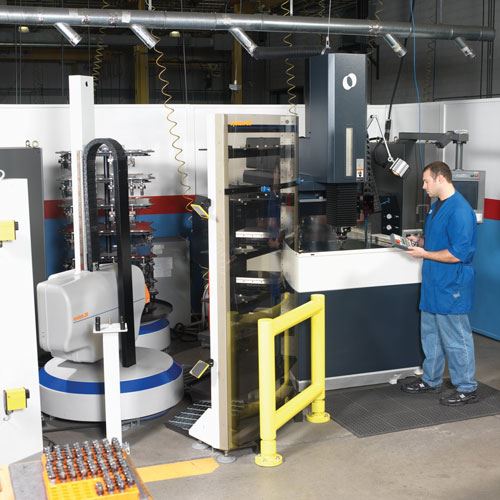Automation: Where to Begin And End
How mold manufacturers are benefitting from today’s automation options.
Automation of machining operations is becoming essential for North American manufacturers to compete globally. With increased machine uptime, capacity and shorter production leadtimes, machining automation provides manufacturers with an edge, enhancing machine efficiencies, increasing revenue streams and improving their overall competitive position in the marketplace.
Mold manufacturers are especially benefiting from the automation options afforded to them. Automation systems are helping them to increase the flexibility of their shop resources and reduce manufacturing costs by minimizing labor costs, eliminating ergonomic issues, improving machine efficiencies and production time, and reducing inventories, leadtimes and setup times. These mold manufacturers are also seeing the increased revenue potential that machining automation offers through improved machine capacity, job turnarounds, work organization, tracking and customer perceptions. But, in order for mold manufacturers to truly realize the potential benefits afforded by machining automation, it is key to have a strategic plan in place for implementation.
Search for the Best Candidate
When looking for the best automation equipment for a particular operation, ROI and ease of implementation are key. By looking for a solution that will address issues of labor-intensive operations, ergonomic issues, low machine efficiencies and long product life, mold manufacturers can fully examine the potential for the best ROI. And, they can always start simple if necessary, addressing their immediate needs and expanding over time to achieve additional benefits.
Justification and Kick-Off
By fully predicting and planning for any reductions in labor, setup time, scrap, shop supplies, utilities and worker compensation claims as well as any increases in machine efficiencies and capacity, mold manufacturers can develop a complete business case to justify the purchase. At that point, the kickoff can begin with project team creation and supplier selection. By covering all of the bases with a project leader and manufacturing engineering, process engineering, operations, maintenance, quality and safety experts, mold manufacturers can be fully prepared to select the best automation supplier—a decision that should be based on the supplier’s product offering, manufacturing and machining expertise as well as the nature of the potential partnership.
Define System Operation
Definition of the system operation involves analysis of the flow of work through the shop, including raw materials and finished product input, auxiliary processing and floor space requirements. It also entails analyzing the various automation requirements—such as unattended operation (which would include machine options like tool life monitoring, tool breakage detection, part probing and pallet seat detection) as well as fixture features like chip shed, part seat detection and hydraulic control. Additional factors to consider during this phase include machining process management, process checks, exception handling, future expandability options, periodic re-evaluation and system acceptance or run-off criteria.
Execution
If the system is successfully justified, chosen and defined, execution can be a smooth process. Once design reviews, approvals and any necessary simulations are completed, the mold manufacturer can begin the installation and training phase. To ensure a seamless transition throughout this phase, all internal resources should be involved during the installation and final acceptance phase to maximize potential efficiencies. Full training for operations, maintenance and troubleshooting is also highly recommended for the most effective implementation of machining automation systems.
As the actual start-up and production ramp-up begins, mold manufacturers should also ensure appropriate support with documentation, spare parts inventory and PM schedules.
All in all, machining automation affords numerous benefits to mold manufacturers when implemented correctly. These systems can help them to achieve improved efficiencies and reduced costs, inventories and set-up times, ultimately resulting in increased revenue potential and flexibility of shop resources. If strategically utilized, machining automation truly offers mold manufacturers a unique way to achieve lean, state-of-the-art machine shops to stay ahead of the competition and maximize financial success.
Related Content
Quality Tool & Die Enhances Performance With Advanced EDM and Milling Technologies
The adoption of Mitsubishi wire and sinker EDMs, along with the OPS Ingersoll five-axis milling machine with automated cells, has enabled unmanned operations and improved precision. As a result, QTD has expanded its facility, grown its workforce and increased its business by 10-15% annually.
Read MoreFive-Axis Graphite Mill With Automation Debottlenecks Electrode Machining
Five-axis electrode cutting enabled Preferred Tool to EDM complex internal screw geometry on an insert that otherwise would have had to be outsourced.
Read MoreTool Paths, ERP & Improving Efficiency in Your Toolroom: What Did You Miss in February?
We covered a variety of topics in February. From tool paths to ERP and PTXPO coverage, we hope you didn’t miss anything but here is your cheat sheet if you did.
Read MoreMachine Hammer Peening Automates Mold Polishing
A polishing automation solution eliminates hand work, accelerates milling operations and controls surface geometries.
Read MoreRead Next
Automation Innovations
The use of automation continues to rise as mold manufacturers respond to industry demand of constantly shrinking leadtimes. Manufacturers and suppliers have taken action with better, faster equipment and processes.
Read MoreReasons to Use Fiber Lasers for Mold Cleaning
Fiber lasers offer a simplicity, speed, control and portability, minimizing mold cleaning risks.
Read MoreHow to Use Strategic Planning Tools, Data to Manage the Human Side of Business
Q&A with Marion Wells, MMT EAB member and founder of Human Asset Management.
Read More






















